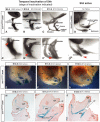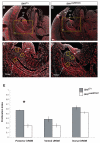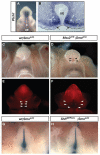Multiphasic and tissue-specific roles of sonic hedgehog in cloacal septation and external genitalia development
- PMID: 19906862
- PMCID: PMC2778742
- DOI: 10.1242/dev.042291
Multiphasic and tissue-specific roles of sonic hedgehog in cloacal septation and external genitalia development
Abstract
Malformations of the external genitalia are among the most common congenital anomalies in humans. The urogenital and anorectal sinuses develop from the embryonic cloaca, and the penis and clitoris develop from the genital tubercle. Within the genital tubercle, the endodermally derived urethral epithelium functions as an organizer and expresses sonic hedgehog (Shh). Shh knockout mice lack external genitalia and have a persistent cloaca. This identified an early requirement for Shh, but precluded analysis of its later role in the genital tubercle. We conducted temporally controlled deletions of Shh and report that Shh is required continuously through the onset of sexual differentiation. Shh function is divisible into two temporal phases; an anogenital phase, during which Shh regulates outgrowth and patterning of the genital tubercle and septation of the cloaca, and a later external genital phase, during which Shh regulates urethral tube closure. Disruption of Shh function during the anogenital phase causes coordinated anorectal and genitourinary malformations, whereas inactivation during the external genital phase causes hypospadias. Shh directs cloacal septation by promoting cell proliferation in adjacent urorectal septum mesenchyme. Additionally, conditional inactivation of smoothened in the genital ectoderm and cloacal/urethral endoderm shows that the ectoderm is a direct target of Shh and is required for urethral tube closure, highlighting a novel role for genital ectoderm in urethragenesis. Identification of the stages during which disruption of Shh results in either isolated or coordinated malformations of anorectal and external genital organs provides a new tool for investigating the etiology of anogenital malformations in humans.
Figures






References
-
- Arsic D., Qi B. Q., Beasley S. W. (2002). Hedgehog in the human: a possible explanation for the VATER association. J. Paediatr. Child Health 38, 117-121 - PubMed
-
- Cassini P., Montironi A., Botti S., Hori T., Okhawa H., Stella A., Andersson L., Giuffra E. (2005). Genetic analysis of anal atresia in pigs: evidence for segregation at two main loci. Mamm. Genome 16, 164-170 - PubMed
-
- Cheng W., Yeung C. K., Ng Y. K., Zhang J. R., Hui C. C., Kim P. C. (2008). Sonic Hedgehog mediator Gli2 regulates bladder mesenchymal patterning. J. Urol. 180, 1543-1450 - PubMed
-
- Dassule H. R., Lewis P., Bei M., Maas R., McMahon A. P. (2000). Sonic hedgehog regulates growth and morphogenesis of the tooth. Development 127, 4775-4785 - PubMed
-
- Dawrant M. J., Giles S., Bannigan J., Puri P. (2008). Adriamycin produces a reproducible teratogenic model of gastrointestinal atresia in the mouse. Pediatr. Surg. Int. 24, 731-735 - PubMed
Publication types
MeSH terms
Substances
Grants and funding
LinkOut - more resources
Full Text Sources
Molecular Biology Databases

